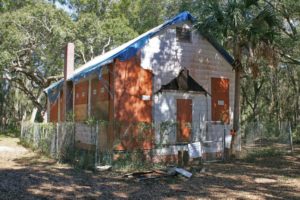
The Harrington School of St. Simons Island, Georgia. Image courtesy of St. Simons African American Heritage Coalition.
After decades of abandonment and disrepair, a one-room schoolhouse that served to educate Black children on Georgia’s St. Simons Island in the 1920s is nearing the end of much-needed renovation, thanks to the work of a few preservationists.
The Harrington School, located on the tiny barrier island just off the coast of Georgia, taught about 15 to 40 students of all ages and grade levels, and served as an anchor in the island’s predominately African-American community, according to the Associated Press. But after the start of desegregation in the early 1960s, the single-room school was eventually deserted and began to rot after years of neglect. It even faced the threat of demolition.
However, a team of preservationists banded together to save the historic school and are now nearly complete in their seven-year project to renovate it.
Friends of the Harrington School, the fundraising group for the renovation project, announced this month that it was awarded a grant that could provide the $50,000 needed to restore the school’s interior. The group hopes to have it renovated and ready to open by February.
“It’s a bridge from the times of slavery through the years up to the civil rights era,” said Patty Deveau, the president of the fundraising group. “St. Simons Island has a rich plantation history, but not many places talk about the 150 years of freedom.”
Historians are unsure of exactly when the Harrington School was built, but it was likely during the 1920s, when thousands of schools for Black students were being constructed across the South as part of a cooperative effort between Booker T. Washington’s Tuskegee Institute and Julius Rosenwald, the CEO of Sears, Roebuck and Co., the Associated Press reported.
During this time, nearly three-fourths of the island’s population were the descendants of enslaved Africans. Now known as the Gullah/Geechee, they have successfully maintained their cultural heritage, language and mannerisms to this day, thanks in part to their isolation from Georgia’s mainland. Today, St. Simons Island is home to over 12,000 white residents and serves as a luxurious seaside resort. The Harrington School is the last remaining Black schoolhouse on the island.
“The reason they built the Harrington School was because they wanted a better life for their children,” Amy Roberts, head of the St. Simons African-American Heritage Coalition, said of her neighbors, the Johnsons, who ran the schoolhouse when she was a student there in the mid-1950s. “Mrs. Johnson played the piano and she had the younger children. We used to sing. We had to do a Bible verse that begins with a different letter of the alphabet everyday.”
After Glynn County schools were desegregated in the 1960s, the historic one-room school was turned into a day care up until the 1970s, according to the news site. The 1,250-square-foot building was slated for demolition in 2010, however, when it was found abandoned. There was a gaping hole in the siding and gaps in its metal roof had allowed rainwater to seep in. Termites also had infested the crawlspace underneath its pine floorboards.
The Glynn County Commission said the schoolhouse was beyond repair, but Roberts and a team of preservationists visited the site and determined that its foundation was structurally sound. There was still much work needed to restore the rest of the building, though.
The Associated Press reported that almost $300,000 has been spent on a new roof, repairing the windows and rebuilding the steps and portico leading up to the front door. Other repairs such as installing the electrical wiring, sanding and finishing the floorboards and giving the interior a fresh coat of paint still need to be done.
With the grant from the Watson-Brown Foundation that will match private donations dollar for dollar up to $25,000, the preservationists hope they’ll be able to complete the project. According to Deveau, nearly $10,000 had already been raised by mid-December.
Roberts, who said she “went a little crazy” when the commission threatened to tear the school down, said she’s happy to finally see the light at the end of the tunnel.
“Now, it is so near the finish the line,” she said. “And it’s gorgeous.”


